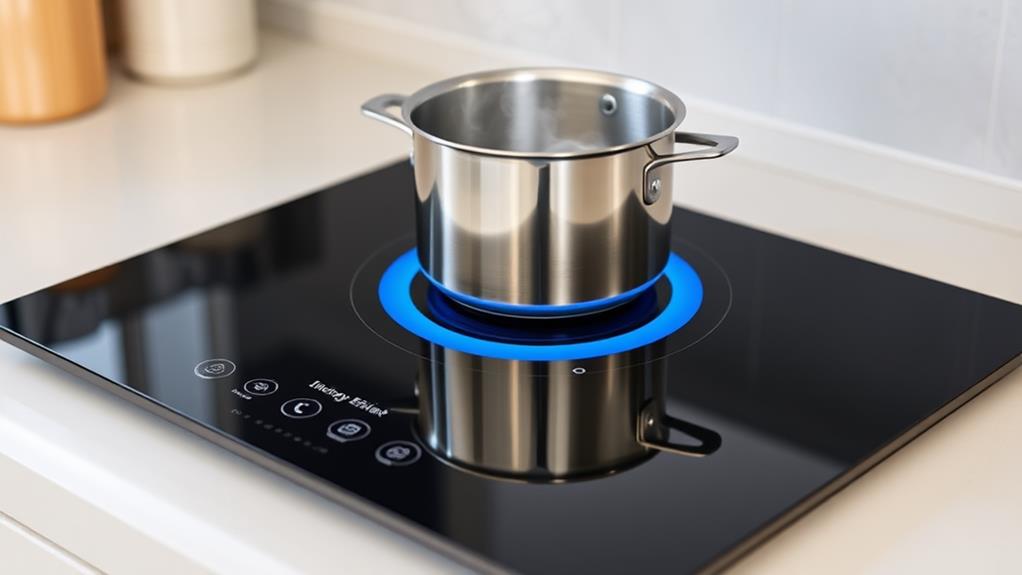Induction cooktops are revolutionizing kitchens with their energy-efficient cooking technology. You'll experience faster heating, precise temperature control, and up to 90% energy conversion efficiency. These cooktops use magnetic fields to heat your cookware directly, keeping the surface cool and reducing safety risks. You'll enjoy responsive temperature changes, preventing overcooking and energy waste. With automatic shut-offs, child safety locks, and sensors, induction cooking offers peace of mind. Plus, you'll reduce your carbon footprint and potentially lower utility bills. The environmental benefits and cooking precision make induction cooktops a game-changer for home chefs. Discover how this technology is reshaping modern cooking methods.
How Induction Cooking Works
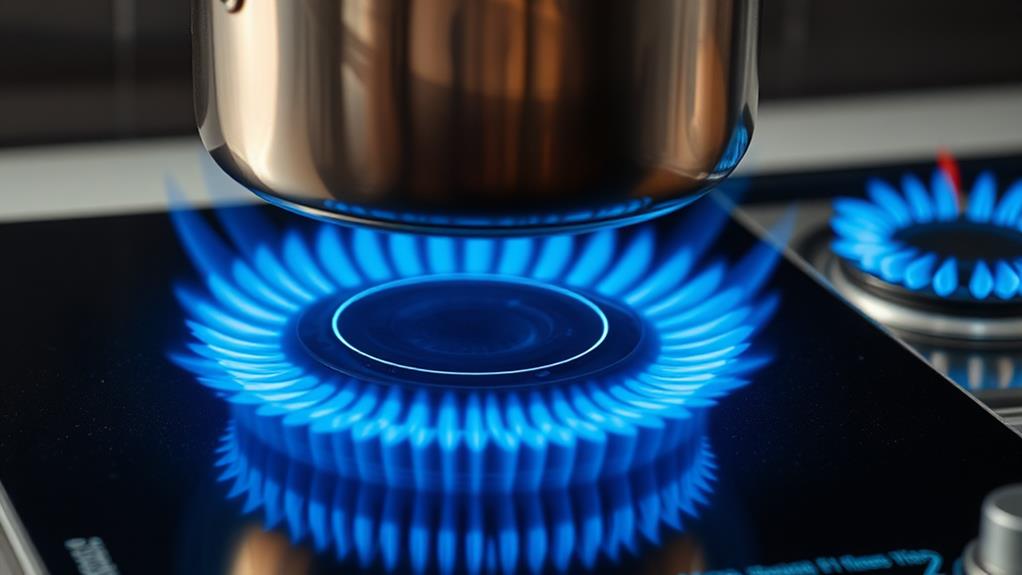
Induction cooking relies on three key components: a magnetic coil, an alternating electric current, and a compatible pot or pan. When you turn on an induction cooktop, electricity flows through the coil, creating a magnetic field. This field rapidly changes direction as the current alternates.
Your cookware must contain ferromagnetic materials like iron or some stainless steels to work with induction. When you place a compatible pot on the cooktop, the changing magnetic field induces electric currents within the metal of the cookware. These currents, known as eddy currents, generate heat through a process called Joule heating.
The heat is produced directly in the pot or pan, not on the cooktop surface. This makes induction cooking highly efficient, as almost all the energy goes into heating your food. You'll find that induction cooktops heat up faster than traditional electric or gas stoves and offer precise temperature control.
Since the cooking surface itself doesn't get hot, it's safer to use and easier to clean. You'll only feel residual heat from the cookware after you've finished cooking.
Energy Efficiency Advantages
The energy efficiency of induction cooking stands out as one of its primary advantages. When you use an induction cooktop, you'll find that it's significantly more efficient than traditional gas or electric stoves. Induction cooking transfers heat directly to the pot or pan, resulting in less energy waste and faster cooking times.
You'll notice that induction cooktops convert about 90% of the energy they use into heat for cooking, compared to only 50-60% for gas stoves and 70-80% for traditional electric cooktops. This means you're using less energy to cook your meals, which can lead to lower utility bills and a reduced carbon footprint.
Another efficiency advantage you'll appreciate is the precise temperature control. Induction cooktops respond instantly to changes in temperature settings, allowing you to fine-tune your cooking with ease. This responsiveness not only saves energy but also helps prevent overcooking or burning your food. Additionally, since the cooktop surface itself doesn't heat up, you'll waste less energy through ambient heat loss. This feature also contributes to a cooler kitchen environment, potentially reducing your air conditioning costs during hot weather.
Safety Features of Induction Cooktops
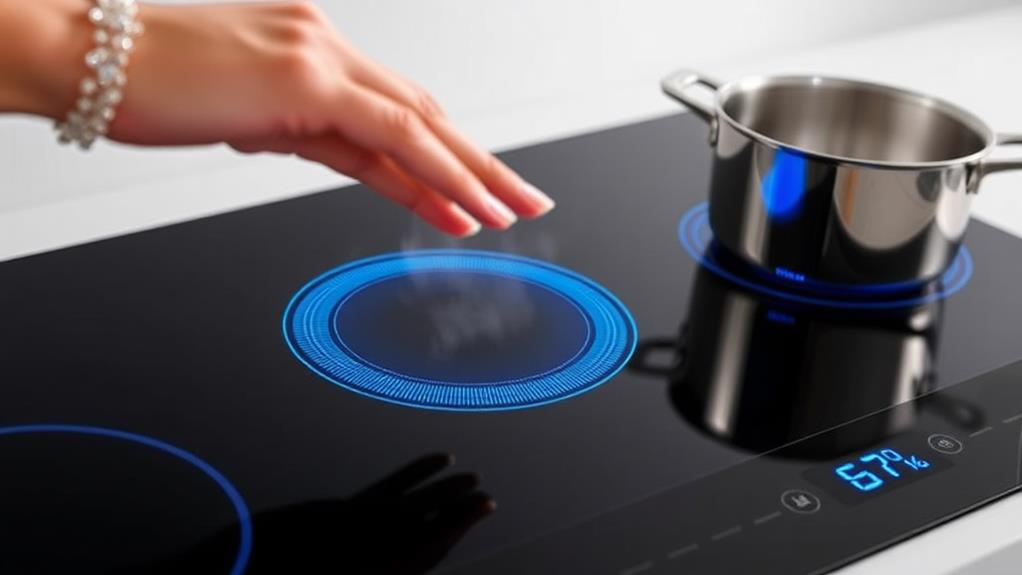
Along with their energy efficiency, induction cooktops offer impressive safety features that set them apart from traditional cooking methods. One of the most notable safety advantages is that the cooktop surface itself doesn't heat up. Instead, it transfers electromagnetic energy directly to the cookware, leaving the surrounding area cool to the touch. This significantly reduces the risk of burns and accidental fires.
You'll also appreciate the automatic shut-off feature of induction cooktops. If no cookware is detected on the surface, the cooktop won't activate, preventing accidental heating. Many models also include timers that automatically turn off the heat after a set period, reducing the risk of overheating or fires caused by forgetfulness.
Induction cooktops often come with child safety locks, allowing you to disable the controls when not in use. This prevents curious children from accidentally turning on the cooktop. Additionally, most induction cooktops have built-in sensors that detect overheating or boil-overs, automatically adjusting the temperature or shutting off the unit to prevent accidents. These safety features make induction cooking a smart choice for households with children or elderly members.
Precision Temperature Control
Precision control stands out as one of the most significant advantages of induction cooktops. Unlike traditional gas or electric stoves, induction cooktops offer you unparalleled accuracy in temperature regulation. You'll find that these cooktops respond instantly to changes in heat settings, allowing you to fine-tune your cooking process with ease.
When you're simmering delicate sauces or melting chocolate, you'll appreciate the ability to maintain a steady, low heat without fear of scorching. On the other hand, if you need to quickly bring water to a boil or sear a steak, you can rapidly increase the temperature without waiting for the cooktop to heat up. This responsiveness isn't just convenient; it's a game-changer for precise cooking techniques.
Many induction cooktops come equipped with pre-set temperature modes for specific cooking tasks. You'll be able to select the exact temperature you need for tasks like deep-frying, sous-vide cooking, or keeping food warm. Some models even feature built-in temperature probes that automatically adjust the heat to maintain your desired temperature, taking the guesswork out of cooking and ensuring consistent results every time.
Environmental Impact
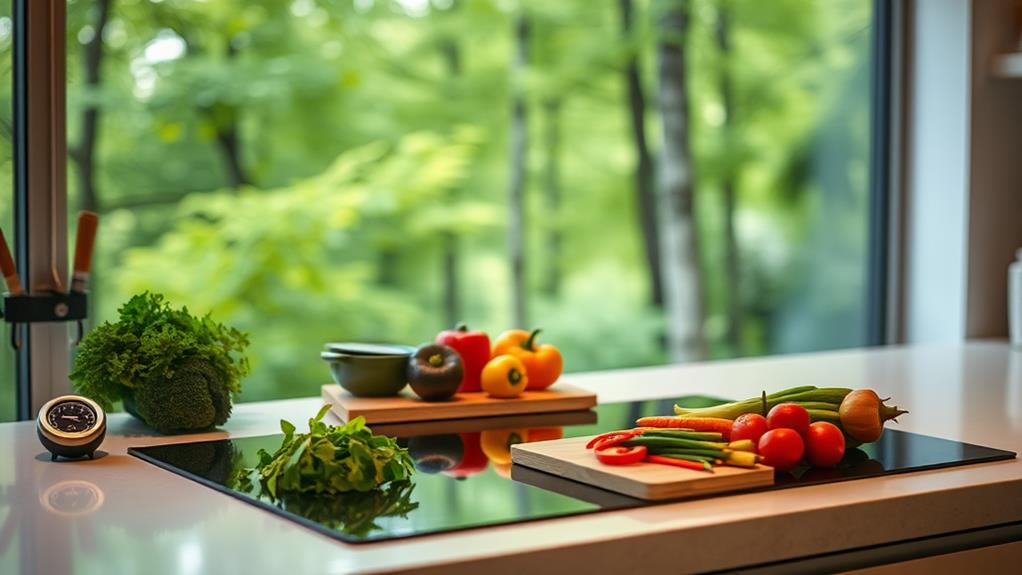
While precision control offers significant benefits for cooking, induction cooktops also shine when it comes to environmental considerations. You'll find that these innovative appliances are more energy-efficient than traditional gas or electric stoves. They use electromagnetic fields to heat cookware directly, wasting less energy in the process.
When you cook with induction, you're using up to 90% of the energy produced, compared to about 74% for traditional electric and 40% for gas stoves. This efficiency translates to lower energy consumption and reduced utility bills. You're not just saving money; you're also reducing your carbon footprint.
Induction cooktops don't emit harmful gases or contribute to indoor air pollution, unlike gas stoves. They're safer for your health and the environment. Additionally, their quick heating and cooling properties mean you'll spend less time cooking, further reducing energy use.
The production of induction cooktops does have some environmental impact, primarily due to the electronics involved. However, their long-term energy savings and efficiency often outweigh these initial costs. By choosing induction, you're making a choice that benefits both your kitchen and the planet.
Cost Considerations
Affordability often plays a crucial role in kitchen appliance decisions, and induction cooktops are no exception. When considering an induction cooktop, you'll find that initial costs are typically higher than traditional gas or electric options. However, it's essential to look beyond the upfront price tag.
Induction cooktops can save you money in the long run through energy efficiency. You'll notice lower electricity bills due to their precise heat control and shorter cooking times. Additionally, these cooktops often come with advanced features that can justify the higher price point.
Don't forget to factor in potential installation costs. If you're switching from gas, you may need to hire an electrician to install a new circuit. However, if you're replacing an electric cooktop, the transition is usually straightforward.
Consider the durability of induction cooktops as well. They generally have a longer lifespan than traditional options, which can offset the initial investment over time. Also, check for available rebates or incentives in your area, as some utilities offer programs to encourage energy-efficient appliance adoption.
Cookware Compatibility
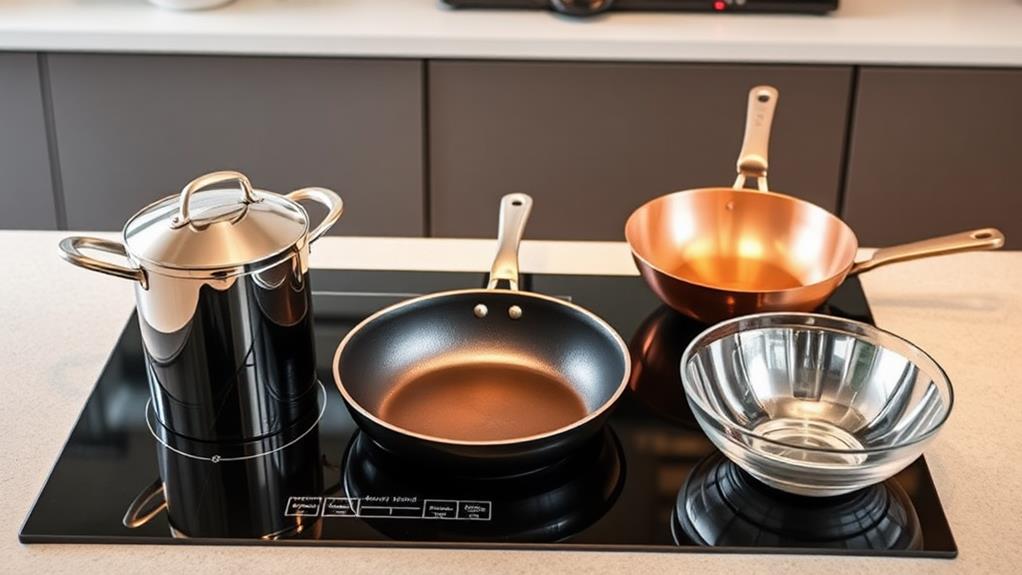
When considering an induction cooktop, you'll need to pay attention to more than just the price tag. Cookware compatibility is a crucial factor that can impact your cooking experience and potentially add to your overall costs.
Induction cooktops work by creating a magnetic field that directly heats the cookware. For this to happen, your pots and pans must be made of ferromagnetic materials. Cast iron and most stainless steel cookware are compatible, but aluminum, copper, and glass are not. You can easily test your existing cookware by seeing if a magnet sticks to the bottom. If it does, you're good to go.
If you find that your current cookware isn't compatible, you'll need to invest in new pots and pans. This can be an additional expense, but it's also an opportunity to upgrade your kitchen equipment. Many manufacturers now produce induction-ready cookware, which is clearly labeled for your convenience. Some even offer adapter plates that can make non-compatible cookware usable on induction cooktops, though these may reduce efficiency and heating speed.
Cleaning and Maintenance
Ease of maintenance is a significant advantage of induction cooktops. Unlike traditional stovetops, induction surfaces don't heat up, which means spills and splatters won't burn onto the cooktop. You'll find cleaning is a breeze – simply wipe the surface with a damp cloth or sponge after each use. For tougher stains, use a mild detergent or a specialized glass cooktop cleaner.
To maintain your induction cooktop's performance, avoid sliding heavy or rough-bottomed cookware across the surface, as this can cause scratches. Always lift pots and pans when moving them. Regularly check the ventilation areas to ensure they're free from dust and debris. If you notice any cracks on the glass surface, stop using the cooktop immediately and contact a professional for repair.
Induction cooktops have no exposed heating elements, reducing the risk of food particles getting trapped. This design also eliminates the need for deep cleaning or replacing burner components. By following these simple maintenance tips, you'll keep your induction cooktop looking new and functioning efficiently for years to come.
Induction vs. Traditional Cooking Methods
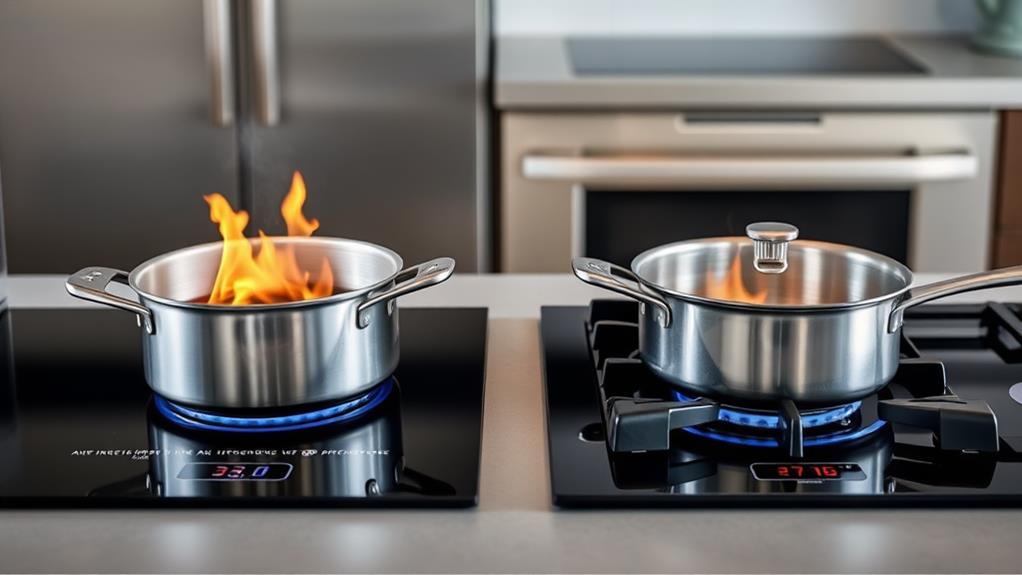
While induction cooktops offer impressive maintenance benefits, their cooking performance truly sets them apart from traditional methods. You'll notice the difference immediately in speed and precision. Induction cooktops heat up faster than gas or electric stoves, allowing you to start cooking sooner. They also provide instant temperature changes, giving you greater control over your cooking process.
Unlike traditional methods, induction cooktops don't waste heat. They transfer energy directly to the cookware, making them up to 90% energy-efficient compared to gas stoves' 40-55% efficiency. This means your kitchen stays cooler, and you'll save on energy bills.
Safety is another key advantage. Induction cooktops only heat the cookware, leaving the surrounding surface cool to the touch. This reduces the risk of burns and makes cleaning up spills easier.
You'll also appreciate the even heating distribution. Induction technology ensures consistent temperatures across the entire cooking surface, eliminating hot spots that can lead to unevenly cooked food.
However, you'll need to use induction-compatible cookware, which may require an initial investment if you don't already own suitable pots and pans.
Future of Kitchen Technology
The kitchen's future is rapidly evolving, with induction cooktops at the forefront of innovation. As you embrace this technology, you'll witness a shift towards more energy-efficient and intelligent cooking appliances. Smart induction cooktops will integrate seamlessly with your home's IoT ecosystem, allowing you to control and monitor your cooking remotely.
You'll soon see induction cooktops with built-in scales and temperature sensors, providing precise control over your culinary creations. These advanced features will enable you to replicate restaurant-quality dishes with ease. Expect to find cooktops that recognize cookware and automatically adjust settings for optimal cooking performance.
The future also holds promise for induction technology beyond cooktops. You'll encounter induction-powered countertops that can heat food anywhere on their surface, eliminating the need for designated cooking zones. As sustainability becomes increasingly important, you'll find induction appliances that harness renewable energy sources, further reducing your carbon footprint.
As kitchens become more high-tech, you'll experience a fusion of traditional cooking methods with cutting-edge technology. Induction cooktops will continue to lead this revolution, offering you unprecedented control, efficiency, and convenience in your culinary endeavors.
Conclusion
As you stand before your sleek induction cooktop, you're not just cooking—you're embracing the future. Picture the invisible magnetic waves dancing beneath your pan, stirring up culinary magic. You're wielding precision, safety, and efficiency in one stylish package. With each meal, you're reducing your carbon footprint and revolutionizing your kitchen. The sizzle of innovation is in the air, and you're at the forefront of this tasty technological evolution.
